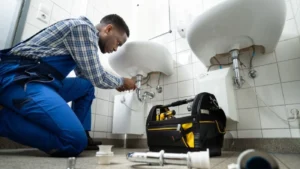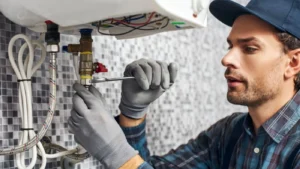Want to win more jobs with less effort?
Grow your business and send quick quotes with our home service software.

Want to see your potential revenue?
See what businesses like yours earn with Housecall Pro in 1 - 2 minutes.
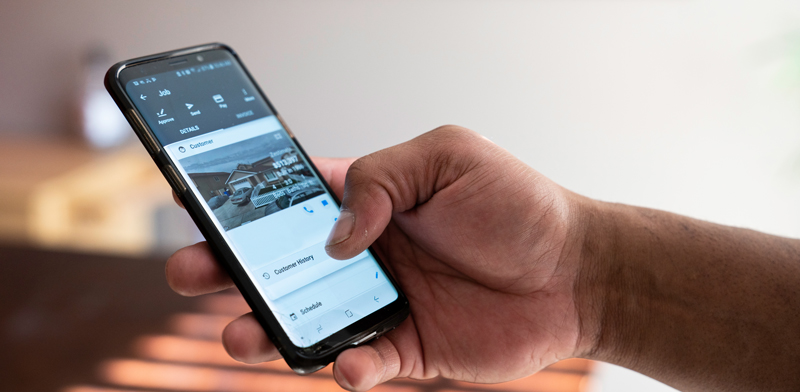
There are currently over 504,000 plumbers in the U.S. all competing for the same customers. Word of mouth still matters, but it’s not enough to keep your calendar full.
To stand out in 2025, you need a clear plumbing marketing plan that combines reputation, local SEO, and smart digital outreach. You don’t need a marketing degree—just the right strategy, consistent effort, and tools that connect you with customers where they’re already searching online.
At Housecall Pro, we’ve helped thousands of plumbers grow their businesses with practical marketing ideas and automation tools that actually work.
In this guide, you’ll learn how to market your plumbing business using 10 proven strategies from branding and SEO to social media and direct mail—that attract new customers and keep them coming back.
How to market your plumbing business
- 1. Build a strong plumbing brand identity
- 2. Create a professional plumbing website that converts
- 3. Optimize your plumbing website for SEO
- 4. Run PPC and Google Local Service Ads for plumbers
- 5. Use direct mail marketing to reach local plumbing customers
- 6. Generate plumbing leads with reviews and referrals
- 7. Use social media for plumbing marketing
- 8. Run paid social ads to reach local homeowners
- 9. Build an email and SMS marketing strategy
- 10. Advertise your plumbing business with vehicle wraps and signage
- 11. Network and partner locally to grow your plumbing business
- How to make a plumbing marketing plan (step-by-step)
- How Housecall Pro helps plumbers market their business
1. Build a strong plumbing brand identity
Building a strong plumbing business brand is the foundation of every effective marketing plan. A clear, consistent identity helps customers recognize you instantly and builds the trust needed to turn leads into long-term clients.
A professional look also boosts visibility. Homeowners are more likely to click on a Google listing or ad that feels credible and familiar, so your brand directly supports both your SEO and paid plumbing ads.
Here’s how to build a plumbing brand that stands out:
- Choose a memorable business name: Choosing a good business name is the first step in building credibility. For example, “FlowRight Plumbing & Drain Specialists” feels more professional and trustworthy than just “Nick’s Plumbing.”
- Write a clear slogan: Your slogan should highlight what sets you apart in your service area. Keep it short (around four words), simple, free of jargon, and timeless so you don’t need to rework it every few years. If you’re short on ideas, check out our plumbing slogan ideas for inspiration.
- Design a clean, recognizable logo: A professional logo builds trust even if your business is new. You can work with freelancers on platforms like Upwork or Fiverr if you’re on a budget—costs generally range from $20–$2,500, depending on experience.
- Use consistent branding: Consistency across your van wraps, uniforms, business cards, and online platforms makes you memorable to potential customers. Stick to the same color palette, fonts, and tone of voice across all touchpoints.
Pro tip: Use Housecall Pro’s customizable invoice and email templates to keep your plumbing brand consistent across every customer interaction, from booking confirmations to receipts.
2. Create a professional plumbing website that converts
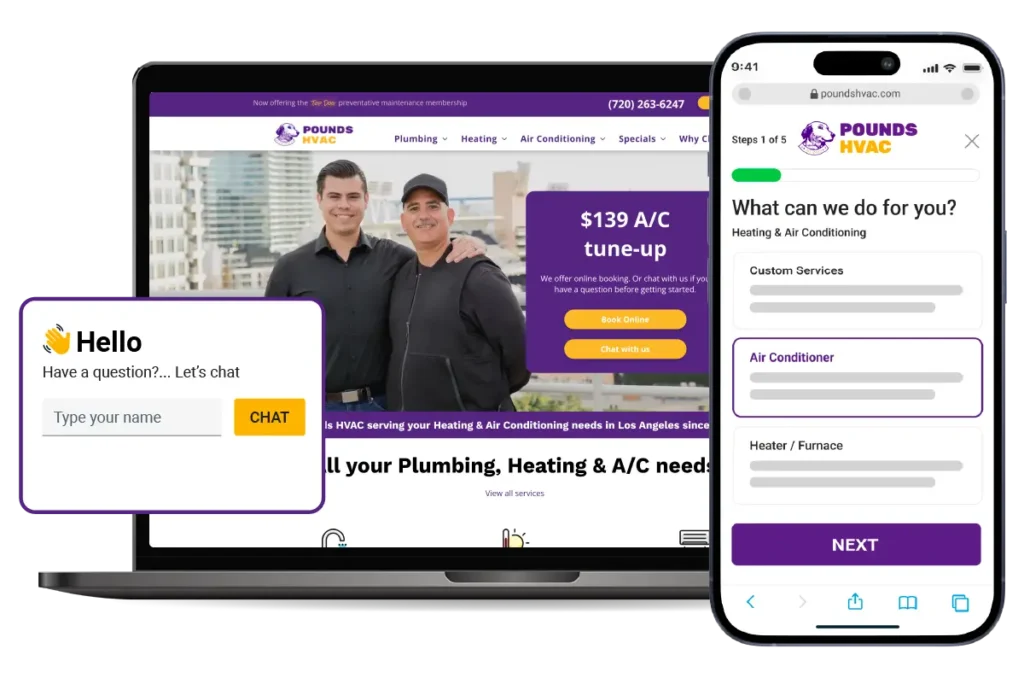
In the U.S., 76% of consumers check a company’s website before visiting in person. This means that even if most of your work comes from referrals, customers still expect you to have a professional plumbing website.
Your site doesn’t need to be complex. “Start with one landing page that highlights your services, service area, and contact info,” says Danny Wilcox, marketing manager at Carini Home Services.
Here are some other essentials to keep in mind:
- Homepage: A quick summary of who you are and why customers should choose you.
- Service page: Detail what types of plumbing you offer (repairs, installations, drain cleaning, new builds, etc.)
- Service area page: Create separate city or neighborhood pages so Google recognizes where you work and locals can find you.
- About page: Tell your company’s story and introduce your team to help customers connect with you on a personal level.
- Contact page: Make it easy to get in touch by including your phone number, business email, and social media contact info. Bonus if you include a short form for quick booking; Housecall Pro’s software can embed online booking directly into your website.
- Reviews page: Highlight past customer experiences as proof of your reliability and quality of work.
Follow these plumbing website design best practices:
- Use simple, easy-to-read fonts and simple navigation.
- Keep page load speeds under two seconds.
- Add photos and videos of completed projects (avoid stock images).
- Make your site mobile-friendly.
Get a professional website without lifting a finger—our team handles it all. Learn more →
3. Optimize your plumbing website for SEO
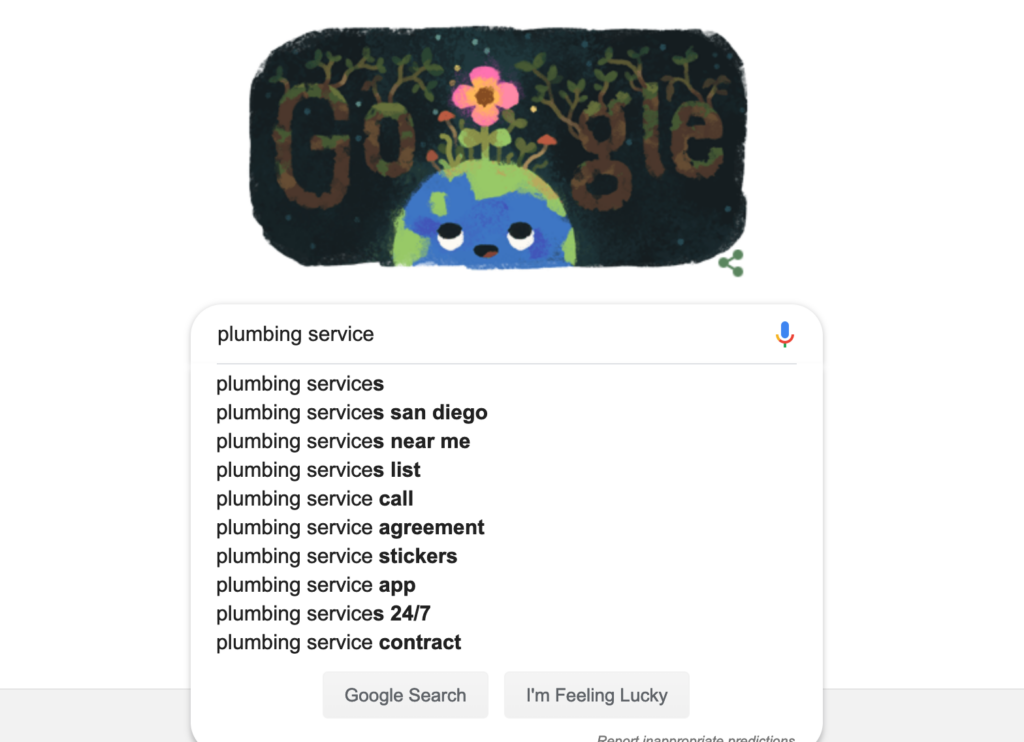
SEO, or search engine optimization, helps your business show up in Google searches like “plumber near me.” Local and on-page SEO are two key areas to focus on.
Local SEO
Local SEO ensures your business appears in Google Maps and local search results where homeowners are most likely to look.
Wilcox recommends starting with these SEO basics:
- Optimize your Google Business Profile (GBP): Include your full business name, address, phone number, service areas, and operating hours. Upload photos of your team, trucks, and completed projects to make your listing more engaging.
- Request reviews consistently: Ask every happy customer to leave a Google review right after a job. Positive reviews not only improve credibility—they’re a major ranking factor.
- Keep your business info consistent: Match your NAP (name, address, phone) across all platforms, including Yelp, Angi, Nextdoor, and Facebook. Inconsistent data can hurt rankings.
- Build local partnerships: Collaborate with nearby realtors, property managers, or home service businesses to earn backlinks and referrals.
On-page SEO
On-page SEO focuses on fine-tuning your website’s content, structure, and technical elements to rank better in search results.
Here’s how to strengthen your plumbing site’s SEO performance:
- Create individual service area pages: Target each city or neighborhood you serve using localized keywords like “plumber in Austin” or “drain cleaning in Round Rock.”
- Add a keyword-rich FAQ section: Address common plumbing questions such as “How much does a plumber cost?” or “How often should I flush my water heater?”
- Publish helpful blog content: Write articles that answer real homeowner questions—e.g., “12 Signs Your Water Heater Needs Replacing” or “What to Do When Your Pipes Freeze.”
- Optimize metadata: Update your homepage title tag and meta description to include your city and services (e.g., “Emergency Plumber in Dallas | Fast 24-Hour Service”).
- Use original project photos: Include before-and-after images with alt text like “Dallas drain repair before and after.”
- Add conversion triggers. Include clear CTAs like “Call Now” or “Book Service” on every page so customers can contact you instantly. Brian Vastola, owner of MRB marketing, notes that the key is to remove any friction: “Make it so easy to contact you that customers don’t even have to think about it.”
→ Learn more in our comprehensive plumbing SEO guide.
4. Run PPC and Google Local Service Ads for plumbers
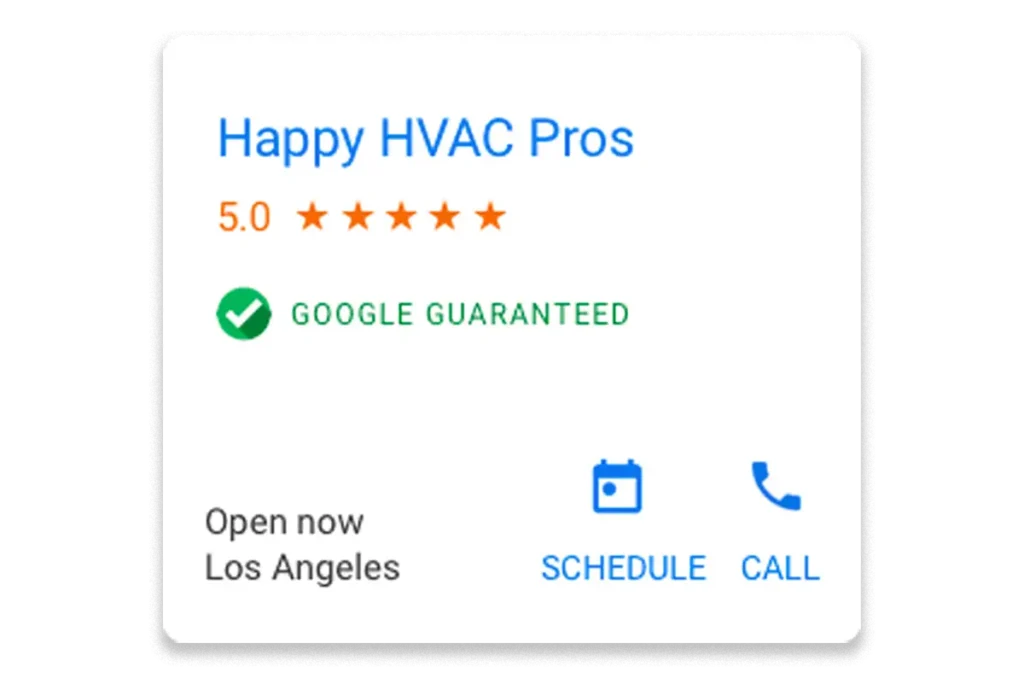
If you want fast, high-intent plumbing leads, PPC (pay-per-click) advertising and Google Local Service Ads (LSAs) are your best tools. While SEO builds long-term visibility, PPC and LSAs help you appear at the top of Google search results immediately—right when homeowners are ready to book a plumber.
Google pay-per-click (PPC) ads
Google Ads let you target searches like “emergency plumber near me” or “water heater repair [City].” You only pay when someone clicks on your ad, so it’s an affordable way to reach high-intent customers who are actively looking for help.
How to set up a successful plumbing PPC campaign:
- Target local, high-intent keywords: Focus on search terms that show strong buying intent, such as “24-hour plumber,” “drain cleaning service near me,” or “toilet repair in [City].”
- Start small and test: Vastola recommends starting small. Rather than diving in with a large budget, run ads for $10–$25 a day and measure which keywords and headlines bring in qualified leads. Adjust your strategy as you gather more data.
- Use ad extensions: Add call, location, and review extensions so customers can contact you directly from your ad.
- Write clear, service-focused copy: Highlight emergency availability, fast response, or upfront pricing—what customers care about most.
- Track every click and call: Use conversion tracking or call tracking to know exactly which ads generate real jobs.
Pro tip: The Google Ads platform isn’t always beginner-friendly. Take time to explore the dashboard and learn how campaigns, keywords, and targeting options work before launching your first campaign.
Google Local Service Ads (LSAs)
Local Service Ads appear above traditional PPC ads, complete with a green “Google Guaranteed” badge that boosts trust. Instead of paying per click, you pay per qualified lead—like a phone call or message from a potential customer.
Why LSAs work for plumbing businesses:
- They show up at the very top of Google results (above PPC and organic).
- The “Google Guaranteed” badge gives homeowners confidence your business is verified and insured.
- You only pay for actual leads, not impressions or clicks.
- Leads come directly through calls or messages, making it easy to respond and close jobs fast.
Tips for getting more leads from LSAs:
- Complete Google’s background and insurance verification process.
- List every service you offer (drain cleaning, leak repair, installations, etc.) to match more searches.
- Respond to every lead quickly—within 1–2 hours if possible. Google rewards responsiveness with higher visibility.
- Focus on your top-performing ZIP codes for maximum ROI.
Pro tip: You don’t need a big budget to start. Even $5–$10 per day can bring in plumbing leads if your targeting and message are on point.
Get In Touch: 858-842-5746
One software to grow your plumbing business
On average, Pros increase monthly revenue generated through Housecall Pro by 35% after their first year.
See plan options and feature breakdown on our pricing page.
5. Use direct mail marketing to reach local plumbing customers
Digital tools are useful, but traditional postcards and letters still work—especially in established neighborhoods. “Direct mail and follow-up phone calls beat any digital combo for steady, high-quality leads,” says Vance Morris, founder of Deliver Service Now, a marketing company that specializes in service businesses.
Why direct mail still works for plumbers:
Direct mail is personal and tangible. While customers can simply scroll by digital ads, they often pin postcards to the fridge or set them on the counter. In fact, in an anonymized case study shared with Housecall Pro by a leading postcard marketing company, home service businesses saw an average ROI of 945% on their direct mail marketing efforts.
Here’s how to create your own plumbing direct mail campaigns:
- Target the right neighborhoods: Focus on owner-occupied homes built 15–25 years ago—these are most likely to need plumbing repairs or upgrades.
- Keep the design clean and local: Use high-contrast colors, easy-to-read fonts, and a headline that mentions your city (“Trusted Dallas Plumber—Fast Same-Day Service!”).
- Include a strong call to action: Add a limited-time offer like “$50 off any repair” or “Free camera inspection with drain cleaning.”
- Track results: Use a unique phone number or QR code for each campaign so you can measure exactly how many calls came from your mailers.
- Follow up: Re-mail to the same area every 60–90 days to build recognition and trust.
Combine direct mail with digital marketing:
- For best results, integrate your print and online strategies:
- Retarget mail recipients later with digital ads on Google or Facebook to reinforce brand recall.
- Send mailers that promote your Google reviews or link to your website booking page.
- Add a QR code that opens your Housecall Pro online booking form, making it easy for homeowners to schedule instantly.
→ See real examples of direct mail marketing campaigns in our guide and try Housecall Pro’s built-in postcard tools to automate outreach, target the right customers, and measure results.
6. Generate plumbing leads with reviews and referrals
Reviews are the new word of mouth. “Every happy customer is another review, another referral, and another person who knows your name,” says Danny Penn, president of New Era Plumbing & HVAC. These are often the first thing customers look at when vetting a new business, so it’s important to invest time into growing your reputation.
Turn every job Into a marketing opportunity
Request reviews right after completing a job, while the experience is still fresh. Use tools like Housecall Pro’s review management software to automate requests and include personalized messaging when possible; this feels genuine and often yields better responses.
Quick wins for getting more plumbing reviews:
- Send a friendly text or email within 24 hours of completing the job.
- Include direct review links for Google, Yelp, and Facebook.
- Respond to every review—positive or negative—to show that you care about customer feedback.
- Feature standout reviews on your website and social media pages for added trust signals.
Want to go further? Set up a referral program with a clear incentive to turn your happy customers into brand advocates. Offer a discount or bonus for each successful referral—something small but valuable to the customer, like a $50 price slash or a free add-on— to encourage repeat business while fueling steady word-of-mouth.
Launch a simple plumbing referral program
Referrals keep your calendar full and your marketing costs low. Reward loyal customers who bring you new business—it builds goodwill and turns happy clients into brand ambassadors.
How to build a referral program that works:
- Offer a small incentive, like $25 off the next service or a free drain inspection for every successful referral.
- Make it easy to share—provide a referral link or printed card with a QR code.
- Track every referral so you can thank customers promptly and measure performance.
- Mention your referral program in invoices, email newsletters, and follow-up texts.
Learn more: How to get more plumbing leads
7. Use social media for plumbing marketing
Facebook, Instagram, Nextdoor, and TikTok are the top platforms for connecting with local homeowners. Each gives you different ways to showcase your work and build trust. Instagram and TikTok are great for visuals and short clips, while Facebook and Nextdoor work well for reviews, local updates, and neighborhood conversations.
What to post on social media
You don’t have to be a content creator to do social media marketing. Authenticity is your asset here; people trust seeing the real faces and results behind your name.
Here are some effective social media post ideas for plumbers:
- Before-and-after photos of completed plumbing jobs.
- Quick video tips explaining how to prevent leaks or clogs.
- Customer testimonials that show off your reliability.
Behind-the-scenes clips of your team at work. - Seasonal maintenance reminders or community event highlights.
8. Run paid social ads to reach local homeowners
Paid Facebook, Instagram, and TikTok ads are powerful for plumbers who want fast visibility. Sprout Social reports that 39% of consumers turn to Facebook when they’re ready to buy. TikTok and Instagram follow closely, at 36% and 29%, respectively. That means your plumbing business has a strong opportunity to stand out early in a customer’s decision-making process. You can even target by ZIP code, homeowner status, or household income so your message reaches people most likely to book.
Tips for successful plumbing social media ads:
- Focus on a clear offer: “$50 off first-time service” or “Free inspection with repair.”
- Use short, eye-catching videos showing real work.
- Pair visuals with strong calls to action like “Call Now” or “Book Instantly.”
- Retarget website visitors who didn’t schedule the first time—they’re often just waiting for a reminder.
9. Build an email and SMS marketing strategy
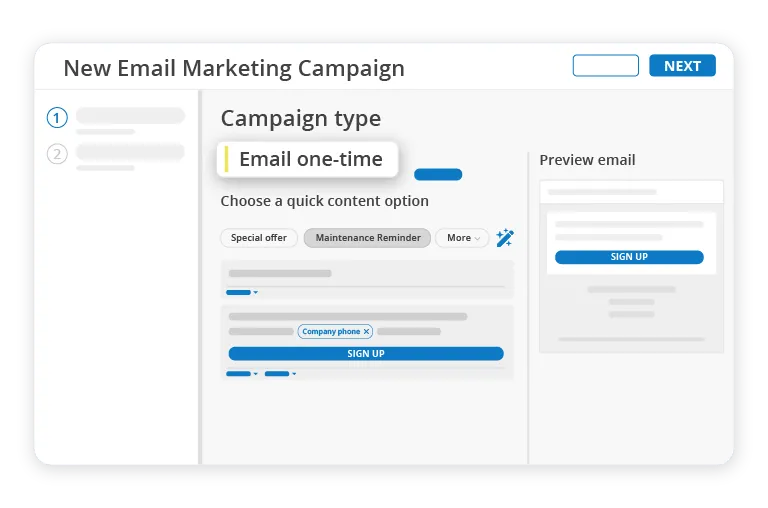
Staying connected with past customers is one of the best ways to generate more bookings. Most homeowners won’t remember who fixed their leak last year, but a friendly reminder in their inbox or text message keeps your company top of mind when they need you again.
Why email and SMS marketing matter
Email and text campaigns deliver some of the highest returns of any plumbing marketing strategy. They’re low-cost, personal, and easy to automate. According to Litmus, every $1 spent on email marketing generates an average ROI of $36—and service businesses often see even higher returns when targeting existing clients.
Here are the best plumbing email campaigns to run:
- Appointment reminders: Prevent no-shows and keep customers organized.
- Seasonal maintenance tips: Examples: “Get your pipes winter-ready” or “Flush your water heater before summer.”
- Special promotions and offers: Reward repeat customers with exclusive discounts.
- Review and referral requests: Ask for a quick review or offer incentives for referrals.
- Thank-you follow-ups: A short thank-you email builds goodwill and trust.
Pro tip: Housecall Pro integrates with Mailchimp and automates campaigns so you can send messages without extra effort.
10. Advertise your plumbing business with vehicle wraps and signage
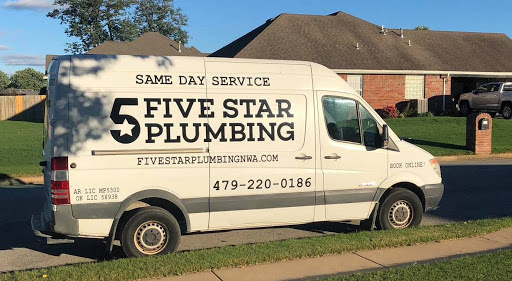
Digital marketing matters, but you still need to be able to reach customers who aren’t online. A professional vehicle wrap or yard sign can generate thousands of local impressions every day, helping homeowners recognize and remember your business before they ever need a plumber.
Use these simple tactics to stay visible in your community:
- Wrap your work van with your logo, slogan, phone number, and website.
- Place yard signs after major projects (with the customer’s permission) to build recognition on the block.
- Hand out magnets or stickers with your business name and contact info. Homeowners can stick them on their fridge or fuse box.
- Use scannable QR codes on all printed materials to make it easy for people to schedule service.
Pro tip: Stick to bold, high-contrast colors that catch the eye but stay consistent with your brand. Make sure your contact info is clear and easy to read from a distance.
Get more plumbing advertising ideas in our comprehensive guide →
11. Network and partner locally to grow your plumbing business
No digital ad beats genuine, local relationships. Partnering with other businesses and community organizations is one of the most reliable ways to earn steady plumbing leads and build long-term trust in your area.
Homeowners and property managers prefer to work with pros they—or their neighbors—know personally. By showing up in your community and building real connections, you position your plumbing company as the go-to service when an emergency strikes.
Here’s how to build strong local partnerships:
- Join your local Chamber of Commerce: Networking events introduce you to other business owners and potential referral partners.
- Collaborate with realtors, property managers, and contractors: Offer maintenance tips or emergency checklists they can share with clients.
- Sponsor community events: Support youth sports, local fairs, or charity fundraisers—visibility in trusted spaces goes a long way.
- Cross-promote services: Team up with HVAC, electrical, or cleaning companies to share leads and co-market seasonal promotions.
- Provide helpful resources: Create branded materials—like a plumbing maintenance checklist or emergency shut-off guide—to hand out or share digitally with local partners.
How to make a plumbing marketing plan (step-by-step)
A plumbing marketing plan gives structure to your efforts and ties your activities to results. Follow these five steps to build a plan that helps you reach new customers and grow your revenue.
Step 1: Define your goals
Start with one or two measurable goals that align with your business priorities. Write them down so you can track progress and adjust strategy when needed.
These are examples of strong, measurable goals:
- Increase monthly service calls by 30%
- Land 12 new property manager contracts this year
- Boost repeat bookings by 15% in six months
- Earn $10,000 in revenue per month in the first quarter
Use SMART goals: Specific, measurable, achievable, relevant, and time-bound.
Step 2: Know your audience
Identify your ideal customers. Are they homeowners, property managers, or commercial clients? Each group has different priorities:
- Homeowners may want fast, affordable emergency repairs.
- Property managers may prioritize reliability and clear communication.
- Commercial clients may need routine inspections and preventive maintenance.
Knowing who you’re speaking to helps you shape your messaging, services, and offers.
Step 3: Pick 2–3 marketing channels to start with
It’s tempting to try a bunch of different channels at once, but this can strain your budget—and time. Start with two or three channels where your target customers are most active.
Based on your goals, you could test a few combinations, like:
- Local SEO and a Google Business Profile to show up in search results
- Google and Yelp reviews to build trust and credibility
- Google Ads and Facebook retargeting to generate plumbing leads
- Vehicle wraps and flyers for neighborhood visibility
Track where your leads come from and how much each one costs to see which channels deliver the best return.
Step 4: Set a realistic budget and timeline
Decide upfront how much you’ll spend based on your goals and business size.Most plumbing companies spend 10%–15% of total revenue on marketing. Once you’ve picked your channels, give each one at least 90 days to show results before scaling or switching.
Step 5: Measure results and adjust monthly
Review your marketing performance on a set day each month. Use call-tracking numbers, website analytics, and customer relationship management (CRM) tools to gather personalized data in real time and spot trends.
Your monthly tracking might include these metrics:
- Number of calls and leads from each channel
- Lead-to-job conversion rate
- Average job size and revenue per lead source
- Repeat booking rate
If a channel isn’t working after three months, shift the budget elsewhere. As a best practice, run small, measurable tests, keep what works, and scale slowly.
How Housecall Pro helps plumbers market their business
Even if you’re a one-person operation, strong systems will save you time and reduce stress. Integrating tools like online scheduling, invoicing, payments, and time tracking helps keep things running smoothly.
Housecall Pro brings everything together in one unified platform, simplifying marketing for plumbers without bouncing between multiple apps. With our plumbing software, you can:
- Request reviews automatically after each job to build your reputation
- Let customers book and pay online to reduce friction
- Stay in touch with targeted email and SMS follow-up campaigns
- Track ROI and adjust your marketing strategy using reporting and analytics
Ready to simplify marketing and grow your business? Sign up for our free 14-day trial and start today.



